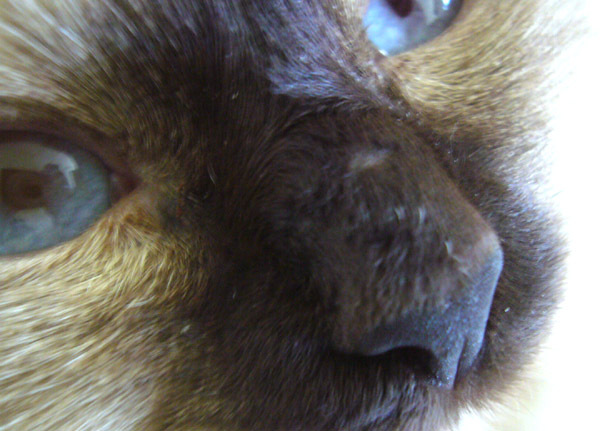Questioni need to know how to tell if your cat is a female or a male i have two kittens and were told they were both females however im not sure, they are 4 months old and i also need to know when a male cat will start to spray if not fixed?
AnswerTammy,
I would recommend that you have a friend or family member who is comfortable holding the kittens gently on their lap. This will allow you to have both hands free to check the reproductive anatomy on each kitten. You will need to lift each kitten's tail so that you can see their anus and reproductive organs. A female kitten will have a small vertical opening beneath her rectum that serves as the opening to her urinary tract as well as her reproductive system. A male kitten will have a scrotum underneath his anus and by four months of age his testicles may well have dropped into the scrotal sac. Another common way of determining the gender is to look at your kittens' back ends while lifting the tail, a female cat's genitals will essentially look similar to a colon (;) while the male's anatomy will look more like a semi-colon (:) if that's easier for you to visualize. I would have liked to have sent you pictures however at this time it would seem as though the option isn't there. The external reproductive anatomy will be somewhat similar to that of human beings although the external genitalia will obviously be somewhat smaller. If you aren't entirely certain what sex the kittens are it would be wise to take them in to see your family vet fairly shortly as males can begin spraying as early as five months of age and female cats can have their first heat cycle in around five months of age or so depending on the genetics, how much she weighs and what your climate is like.
Given that there is a very serious pet overpopulation issue worldwide it's best to avoid breeding your pets. Countless healthy, adoptable cats and kittens are destroyed in animal shelters every year worldwide simply because there isn't enough space to house the millions of unfortunate felines that are admitted to these institutions and unfortunately these animal loving people are forced to make heartbreaking decisions simply because it just isn't possible to house each cat or kitten indefinitely they just don't have the funding or space to hold onto animals indefinitely. In North America only 3% of cats/kittens admitted to animal shelters are reclaimed by their guardians which seems to indicate that people generally view cats as "disposable pets". Surgical sterilization provides a number of health and behavioral benefits beyond the obvious asset: population control. Cats who haven't been sterilized are far more likely to have nasty territorial disputes with other cats in the area.
It's a common myth that spaying or neutering your cat will make him/her fat and lazy. Spaying or neutering your cat/kitten won't change his/her personality, nor will it cause them to gain weight. The reason for this common misconception is that kittens spayed/neutered around the age of 5-6 months are usually in the middle of a growth spurt and they are beginning to be a little less affected by the kitten crazies. Many people believe that surgically sterilizing their cat/kitten is unnatural or even dangerous. The fact is that by allowing an intact female cat to cycle repeatedly while preventing her from mating increases her risk for developing cancers in her reproductive tract and mammary glands which could potentially prove fatal. By allowing a male cat to roam about the neighborhood impregnating other people's cats you are contributing to an already huge overpopulation crisis and unfortunately there is a very real possibility that any offspring your kittens create will end up in an animal shelter at some point during their lives and the sad reality is that many cats and kittens who enter shelter systems never leave just because they weren't wanted. Cats that haven't been spayed/neutered are hard wired to reproduce much the same as any other animal so preventing sexually mature cats from mating can cause serious behavioral issues including aggression, house soiling, fighting with other cats which could potentially lead to very high vet bills to treat abscesses, bite wounds and other common fight injuries.
Many pet guardians have concerns about the risk of surgical complications or death related to spay/neuter procedures. For the most part the risks are very minimal, however no surgery is completely without risk. Spay/neuter procedures are very routine, cats are given a light sedative injection prior to having the appropriate site prepared for surgery as well as an injection of long acting pain medication to avoid the potential for post surgical discomfort. The risks related to anesthesia have been substantially reduced by using safer human anesthetic agents. Cats being spayed or neutered are constantly monitored by a veterinary technician to ensure that their vital signs stay in the normal range. There are many people who believe that surgically sterilizing cats/kittens is morally wrong and unnatural. This is an extremely narrow view and in my experience the benefits of having kittens spayed as early as possible far outweighs the surgical risks in a healthy cat. Spayed and neutered cats enjoy a number of health benefits including a reduced incidence of mammary infections or tumors and the risk of developing prostate, ovarian, uterine or testicular cancers is virtually eliminated. Ultimately spaying and neutering prevents unwanted litters which in turn saves millions of lives every year.Cats that have been surgically sterilized (aka spayed or neutered)tend to be far less likely to wander, fight, or caterwaul and howl to advertise their availability to mate because the urge to mate is completely eliminated. Spaying or neutering your cat/kitten is a responsible step towards humanely reducing the population of homeless cats/kittens, it's a life saving decision.

 cat in labour
Questionxena last night
QUESTION: Hi!
I have a
cat in labour
Questionxena last night
QUESTION: Hi!
I have a
 wonderin??
Question
CIara
Hi Karen,
This is my first time dealing
wonderin??
Question
CIara
Hi Karen,
This is my first time dealing
 identify breed of cat
Question
Male cat 4 years ol
I recently adopted
identify breed of cat
Question
Male cat 4 years ol
I recently adopted
 Trimming (crazy) Kittens Claws
Question
tigerlily
I need to trim my kittens nai
Trimming (crazy) Kittens Claws
Question
tigerlily
I need to trim my kittens nai
 Bald spot on my cats nose
Question
bald spot
Hello Jessica,
Today I notic
Bald spot on my cats nose
Question
bald spot
Hello Jessica,
Today I notic